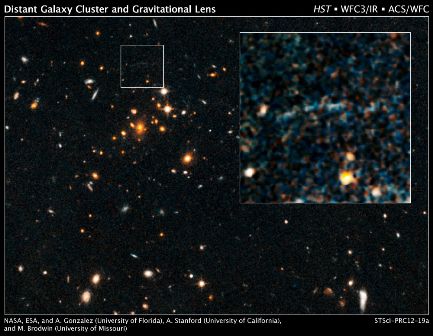Astronomy news
'Impossible' galactic arc threatens
age of universe
1 July 2012
Astronomers using the Hubble Space Telescope have found a puzzling
arc of light behind an extremely massive cluster of galaxies that are 10
billion light-years away. The giant arc is the stretched shape of a more
distant galaxy whose light is distorted by the monster cluster's
powerful gravity, an effect called gravitational lensing.
The trouble is, the arc shouldn't exist.

"When I first saw it, I kept staring at it, thinking it would go
away," said study leader Anthony Gonzalez of the University of Florida
in Gainesville. "According to a statistical analysis, arcs should be
extremely rare at that distance. At that early epoch, the expectation is
that there are not enough galaxies behind the cluster bright enough to
be seen, even if they were 'lensed' or distorted by the cluster.
"The
other problem is that galaxy clusters become less massive the farther
back in time you go. So it's more difficult to find a cluster with
enough mass to be a good lens for gravitationally bending the light from
a distant galaxy."
Galaxy clusters are collections of hundreds to thousands of galaxies
bound together by gravity. They are the most massive structures in our
universe. Astronomers frequently study galaxy clusters to look for
faraway, magnified galaxies behind them that would otherwise be too dim
to see with telescopes. Many such gravitationally lensed galaxies have
been found behind galaxy clusters closer to Earth.
The surprise in this Hubble observation is spotting a galaxy lensed
by an extremely distant cluster. Dubbed IDCS J1426.5+3508, the cluster
is the most massive found at that epoch, weighing as much as 500
trillion suns. It is 5 to 10 times larger than other clusters found at
such an early time in the universe's history. This unique system
constitutes the most distant cluster known to "host" a giant
gravitationally lensed arc.
The arc was spotted in optical images of the cluster taken in 2010 by
Hubble's Advanced Camera for Surveys. The infrared capabilities of
Hubble's Wide Field Camera 3 (WFC3) helped provide a precise distance,
confirming it to be one of the farthest clusters yet discovered.
Once the astronomers determined the cluster's distance, they used
Hubble, the Combined Array for Research in Millimeter-wave Astronomy
(CARMA) radio telescope, and NASA's Chandra X-ray Observatory to
independently show that the galactic grouping is extremely massive.
CARMA helped the astronomers determine the cluster's mass by
measuring how primordial light from the big bang was affected as it
passed through the extremely hot, tenuous gas that permeates the
grouping. The astronomers then used the WFC3 observations to map the
cluster's mass by calculating how much cluster mass was needed to
produce the gravitational arc. Chandra data, which revealed the
cluster's brightness in X-rays, was also used to measure the cluster's
mass.
"The chance of finding such a gigantic cluster so early in the
universe was less than one percent in the small area we surveyed," said
team member Mark Brodwin of the University of Missouri-Kansas City. "It
shares an evolutionary path with some of the most massive clusters we
see today, including the Coma Cluster and the recently discovered El
Gordo Cluster."
An analysis of the arc revealed that the lensed object is a
star-forming galaxy that existed 10 billion to 13 billion years ago. The
team hopes to use Hubble again to obtain a more accurate distance to the
lensed galaxy.
Gonzalez has considered several possible explanations for the arc.
One explanation is that distant galaxy clusters, unlike nearby
clusters, have denser concentrations of galaxies at their cores, making
them better magnifying glasses. However, even if the distant cores were
denser, the added bulk still should not provide enough gravitational
muscle to produce the giant arc seen in Gonzalez's observations,
according to a statistical analysis.
Another possibility is that the initial microscopic fluctuations in
matter made right after the big bang were different from those predicted
by standard cosmological simulations, and therefore produced more
massive clusters than expected.
"I'm not yet convinced by any of these explanations," Gonzalez said.
"After all, we have found only one example. We really need to study more
extremely massive galaxy clusters that existed between 8 billion and 10
billion years ago to see how many more gravitationally lensed objects we
can find."
Only time will tell whether this result is a threat to the calculated
age of the universe.
The team's results are described in three papers, which are
online and will be published in the 10 July, 2012 issue of The
Astrophysical Journal.
To top |